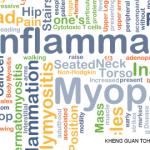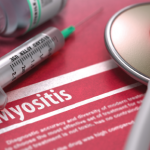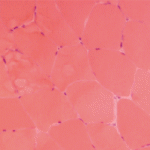 ATLANTA—Despite their toxicity risk, glucocorticoids are a mainstay of treatment for myositis and usually lower a patient’s creatinine kinase level. However, this approach doesn’t mean a patient is actually being treated properly, cautioned an expert during a session at the 2019 ACR/ARP Annual Meeting in November.
ATLANTA—Despite their toxicity risk, glucocorticoids are a mainstay of treatment for myositis and usually lower a patient’s creatinine kinase level. However, this approach doesn’t mean a patient is actually being treated properly, cautioned an expert during a session at the 2019 ACR/ARP Annual Meeting in November.
The discussion touched on myositis management, the importance of exercise and novel therapies being developed.
Treatment Options
“Treatment, not surprisingly, is based on eminence-based medicine—almost exclusively on expert opinion,” said Lisa Christopher-Stine, MD, MPH, director of the Johns Hopkins Myositis Center, Baltimore. “The data we do have are derived from a few randomized clinical trials and small case series and open-label trials.”
Even steroids, which are a principal medication part of the algorithm in most treatment plans, have not been thoroughly studied in myositis, said Dr. Christopher-Stine. The standard dose of 1–2 mg per kg per day up to 80–100 mg per day has “never been trialed independently,” she said. It’s borrowed from other rheumatic diseases.
“No one knows exactly how to taper [steroids],” said Dr. Christopher-Stine. But she then suggested maintaining highdose, oral glucocorticoids for two to four weeks then gradually tapering to a minimally effective dose of 5–7.5 mg a day. In adults, she recommends concomitant glucocorticoid therapy-sparing immunosuppressive therapy within the first two weeks of glucocorticoid treatment.1
For first-line treatments with steroids, methotrexate and azathioprine are mainstays, while mycophenolate, tacrolimus and cyclosporine are used as second-line treatments. These second-line treatments should be limited due to their risk of toxicity. Rituximab is the preferred thirdline treatment, Dr. Christopher-Stine noted. And intravenous (IV) immunoglobulin can be used as a second- or third-line treatment.
Tips for Patient Care
Dr. Christopher-Stine offered additional tips and observations:
Treat the patient, not their creatinine kinase elevation: “Frequently, as physicians and type A personalities, I think we want to normalize everything; sometimes you can’t,” Dr. Christopher-Stine said. If a patient has experienced big improvements in muscle strength, if the creatinine kinase level is below 1,000, even if it may still be abnormal, “don’t feel the need to continue to suppress and suppress just to normalize that muscle enzyme.”
Not all dermatomyositis patients with a normal creatinine kinase are amyopathic: On Christmas Eve a few years ago, Dr. Christopher-Stine had a patient who was on relatively low-dose steroids and very weak, with a normal to low creatinine kinase level. On MRI, “every single muscle group in his thighs lit up with edema,” she said. It was her first indication, she said, that necrosis in the muscle, in addition to inflammation, can cause the creatinine kinase level to rise.
All IV immunoglobulin is not the same: Different brand formulations work differently. After two or three months of a patient not responding to IV immunoglobulin, they can typically be considered an official non-responder. But, she said, “In rare cases, you can switch to another [brand] and [the patient will] randomly respond [to treatment].” For a patient who responds initially to a specific brand that becomes ineffective, another brand may increase efficacy.
Exercise is essential: Exercise is anti-inflammatory and fights atrophy. It induces microRNAs that target transcripts and proteins that are important for muscle and immune response. Gene expression and proteomic analysis of skeletal muscle from patients with myositis have identified important changes in exercised muscle. Plus, endurance exercise for more than 12 weeks has beneficial effects on muscle performance and reduced clinical activity.2
“For years, people told myositis patients not to exercise—stay still and [don’t] exacerbate your disease,” Dr. Christopher-Stine said. “This could not be further from the truth. Please tell your patients to do resistance exercise under the direction of a physical therapist.”
Anti-Mi-2 and other so-called myositis specific antibodies may eventually be helpful: This area of research is a work in progress. “There is no standardization of myositis-specific antibodies,” she said. “The great news is they’ve become readily available to many of you in this audience. The bad news is that we don’t have a standardized platform, and there are many false positives and negatives.”
A small clinical trial at Dr. Christopher-Stine’s center concluded that “a positive may not be a positive, and that we may need different level cutoffs for each autoantibody subset.”3
Novel agents remain unproved: Clinical trials are ongoing for the oral endocannabinoid receptor agonist lenabasum and the subcutaneous KZR-616, a selective inhibitor of the immunoproteasome. “We are in an era where novel mechanisms are upon us,” she said. “We have a lot to be excited about, but a lot to wait for.”
Inclusion body myositis: Several agents are being studied for inclusion body myositis, including arimoclomol, which induces heat shock protein 1 and helps with protein misfolding.
Two older drugs that may have new applications in the disease are rapamycin, which restores protein degradation pathways by inhibiting mTOR, and pioglitazone, which increases expression of AMP kinase and PCG-1 alpha. Pioglitazone, a diabetes drug, is thought to result in increased mitochondrial biogenesis in muscle and may improve exercise capacity and mitochondrial function.
New options in this area would be welcome. “Inclusion body myositis has been one of the most challenging subsets of myositis that we see as clinicians,” said Dr. Christopher-Stine.
Thomas R. Collins is a freelance writer living in South Florida.
References
- Cavagna L, Monti S, Caporali R, et al. How I treat idiopathic patients with inflammatory myopathies in the clinical practice. Autoimmun Rev. 2017 Oct;16(10):999–1007.
- Boehler JF, Hogarth MW, Barberio MD, et al. Effect of endurance exercise on microRNAs in myositis skeletal muscle—a randomized controlled study. PLoS One. 2017 Aug 22;12(8):e0183292.
- Mecoli CA, Casal-Dominguez M, Pak K, et al. Myositis autoantibodies: A comparison of results from the Oklahoma Medical Research Foundation Myositis Panel to the euroimmun research line blot. Arthritis Rheumatol. 2020 Jan;72(1):192–194.



